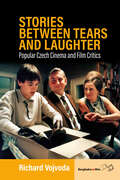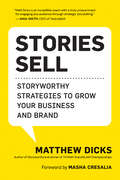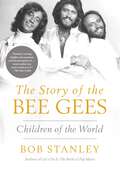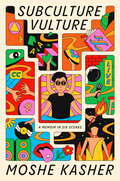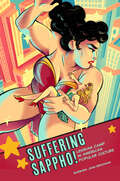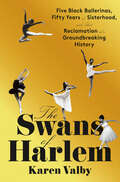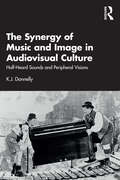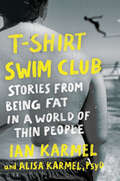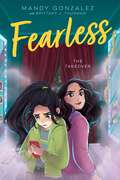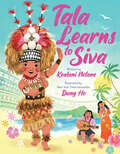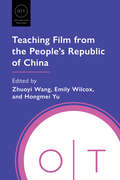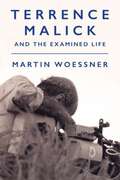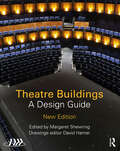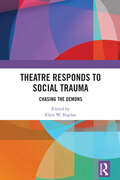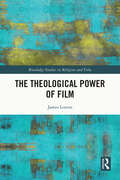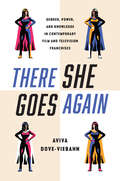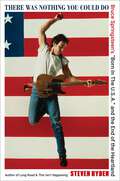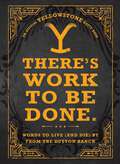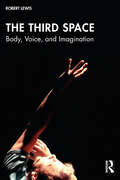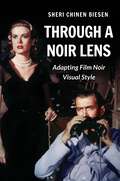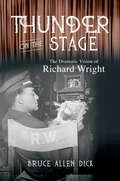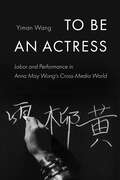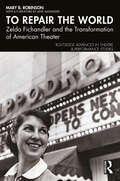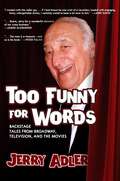- Table View
- List View
Stories between Tears and Laughter: Popular Czech Cinema and Film Critics
by Richard VojvodaWhile histories of Czech cinema often highlight the quality of Czechoslovak New Wave films made in the 1960s, post-socialist Czech cinema receives little attention. Through a methodology of historical reception, Stories between Tears and Laughter explores how attitudes towards post-socialist Czech cinema have shifted from viewing it as radical “art cinema” and more towards popular cinema. By analyzing publicity materials, reviews, and articles, Richard Vojvoda offers a new perspective on the notions of cultural value and quality that have been shaping the history of post-socialist Czech cinema.
Stories Sell: Storyworthy Strategies to Grow Your Business and Brand
by Matthew DicksWIN CUSTOMERS AND BUILD BRANDS THROUGH THE POWER OF STORYTELLING Moth GrandSLAM all-time champion storyteller, writer, and business coach Matthew Dicks presents a guide to using the power of storytelling for success in business of any type or size. Matt has found that the basic principles of effective storytelling are universal, teachable, and more crucial than ever for business communication. Jam-packed with examples, Stories Sell reveals the ingredients of a compelling story and then demonstrates how they can be incorporated into persuasive marketing copy, productive face-to-face conversations, effective sales pitches, and presentations that people actually want to hear. Topics include: • The three elements of a winning story: stakes, suspense, and surprise • Finding the right narrative structure (and why beginning at the beginning isn’t always the best method) • The power of being vulnerable: how admitting your mistakes can build rapport with audiences • When and how to use humor • Zigging while others zag: making yourself stand out from competitors Whether you’re an online marketer, advertising professional, salesperson, small business owner, independent contractor, or Fortune 500 executive, Stories Sell will teach you to find your voice and get your message across for maximum impact and profit.
The Story of The Bee Gees: Children of the World
by Bob StanleyA dazzling biography of one of the bestselling bands of all time, told with brilliant insight by renowned pop music scholar Bob Stanley.The world is full of Bee Gees fans. Yet for a band of such renown, little is known about Barry, Maurice, and Robin Gibb. People tend to have their favorite era of the Bee Gees's career, but many listeners are also conscious that there is more to uncover about the band. This book will provide the perfect solution, by pulling together every fascinating strand to tell the story of a group with the imagination of the Beatles, the pop craft of ABBA, the drama of Fleetwood Mac, and the emotional heft of the Beach Boys. Uniquely, the Bee Gees's tale spans the entire modern pop era—they are the only group to have scored British top-ten singles in the '60s, '70s, '80s, and &‘90s—and includes world-conquering disco successes like 'Stayin' Alive' and 'More Than a Woman', both from the soundtrack of the hit film Saturday Night Fever. But the Bee Gees's extraordinary career was one of highs and lows. From a vicious but temporary split in 1969 to several unreleased albums, disastrous TV and film appearances, and a demoralising cabaret season, the group weren't always revelling in the glow of million-selling albums, private jets, and UNICEF concerts. Yet, even in the Gibbs' darkest times, their music was rarely out of the charts, as sung by the likes of Al Green, Kenny Rogers and Dolly Parton, and Destiny's Child. Capturing the human story at the heart of the Bee Gees, this book is a lyrical and stylish read, delighting hardcore fans with its details while engaging casual pop readers who simply want to know more about this important and enigmatic group.
Subculture Vulture: A Memoir in Six Scenes
by Moshe KasherA &“hilarious&” (Dax Shepard), &“surprisingly emotional trip&” (The Chainsmokers) through deep American subcultures ranging from Burning Man to Alcoholics Anonymous, by the writer and comedian Moshe Kasher &“Part history lesson, part standup set and, often, part love letter . . . Kasher&’s ability to blend humor with homework works almost too well.&”—The New York TimesAfter bottoming out, being institutionalized, and getting sober all by the tender age of fifteen, Moshe Kasher found himself asking: &“What&’s next?&” Over the ensuing decades, he discovered the answer: a lot.There was his time as a boy-king of Alcoholics Anonymous, a kind of pubescent proselytizer for other teens getting and staying sober. He was a rave promoter turned DJ turned sober ecstasy dealer in San Francisco&’s techno warehouse party scene of the 1990s. For fifteen years he worked as a psychedelic security guard at Burning Man, fishing hippies out of hidden chambers they&’d constructed to try to sneak into the event. As a child of deaf parents, Kasher became deeply immersed in deaf culture and sign language interpretation, translating everything from end-of-life care to horny deaf clients&’ attempts to hire sex workers. He reconnects and tries to make peace with his ultra-Hasidic Jewish upbringing after the death of his father before finally settling into the comedy scene where he now makes his living.Each of these scenes gets a gonzo historiographical rundown before Kasher enters the narrative and tells the story of the lives he has spent careening from one to the next. A razor-sharp, gut-wrenchingly funny, and surprisingly moving tour of some of the most wildly distinct subcultures a person can experience, Subculture Vulture deftly weaves together memoir and propulsive cultural history. It&’s a story of finding your people, over and over again, in different settings, and of knowing without a doubt that wherever you are is where you&’re supposed to be.
Suffering Sappho!: Lesbian Camp in American Popular Culture
by Barbara Jane BrickmanAn ever-expanding and panicked Wonder Woman lurches through a city skyline begging Steve to stop her. A twisted queen of sorority row crashes her convertible trying to escape her queer shame. A suave butch emcee introduces the sequined and feathered stars of the era’s most celebrated drag revue. For an unsettled and retrenching postwar America, these startling figures betrayed the failure of promised consensus and appeasing conformity. They could also be cruel, painful, and disciplinary jokes. It turns out that an obsession with managing gender and female sexuality after the war would hardly contain them. On the contrary, it spread their campy manifestations throughout mainstream culture. Offering the first major consideration of lesbian camp in American popular culture, Suffering Sappho! traces a larger-than-life lesbian menace across midcentury media forms to propose five prototypical queer icons—the sicko, the monster, the spinster, the Amazon, and the rebel. On the pages of comics and sensational pulp fiction and the dramas of television and drive-in movies, Barbara Jane Brickman discovers evidence not just of campy sexual deviants but of troubling female performers, whose failures could be epic but whose subversive potential could inspire. Supplemental images of interest related to this title: George and Lomas; Connie Minerva; Cat On Hot Tin; and Beulah and Oriole.
The Swans of Harlem: Five Black Ballerinas, Fifty Years of Sisterhood, and Their Reclamation of a Groundbreaking History
by Karen ValbyA MOST ANTICIPATED BOOK • The forgotten story of a pioneering group of five Black ballerinas and their fifty-year sisterhood, a legacy erased from history—until now.&“This is the kind of history I wish I learned as a child dreaming of the stage!&” —Misty Copeland, author of Black Ballerinas: My Journey to Our Legacy &“Utterly absorbing, flawlessly-researched…Vibrant, propulsive, and inspiring, The Swans of Harlem is a richly drawn portrait of five courageous women whose contributions have been silenced for too long!&” —Tia Williams, author of A Love Song for Ricki WildeAt the height of the Civil Rights movement, Lydia Abarca was a Black prima ballerina with a major international dance company—the Dance Theatre of Harlem, a troupe of women and men who became each other&’s chosen family. She was the first Black company ballerina on the cover of Dance magazine, an Essence cover star; she was cast in The Wiz and in a Bob Fosse production on Broadway. She performed in some of ballet&’s most iconic works with other trailblazing ballerinas, including the young women who became her closest friends—founding Dance Theatre of Harlem members Gayle McKinney-Griffith and Sheila Rohan, as well as first-generation dancers Karlya Shelton and Marcia Sells.These Swans of Harlem performed for the Queen of England, Mick Jagger, and Stevie Wonder, on the same bill as Josephine Baker, at the White House, and beyond. But decades later there was almost no record of their groundbreaking history to be found. Out of a sisterhood that had grown even deeper with the years, these Swans joined forces again—to share their story with the world.Captivating, rich in vivid detail and character, and steeped in the glamour and grit of professional ballet, The Swans of Harlem is a riveting account of five extraordinarily accomplished women, a celebration of both their historic careers and the sustaining, grounding power of female friendship, and a window into the robust history of Black ballet, hidden for too long.
The Synergy of Music and Image in Audiovisual Culture: Half-Heard Sounds and Peripheral Visions
by K.J. DonnellyThe Synergy of Music and Image in Audiovisual Culture: Half-Heard Sounds and Peripheral Visions asks what it means to understand music as part of an audiovisual whole, rather than separate components of music and film. Bringing together revised and updated essays on music in a variety of media – including film, television, and video games – this book explores the importance of partially perceived and registered auditory and visual elements and cultural context in creating unique audiovisual experiences. Critiquing traditional models of the film score, The Synergy of Music and Image in Audiovisual Culture enables readers across music, film, and cultural studies to approach and think about audiovisual culture in new ways.
T-Shirt Swim Club: Stories from Being Fat in a World of Thin People
by Ian Karmel Alisa KarmelComedian Ian Karmel, with help from his sister, Dr. Alisa Karmel, opens up about the daily humiliations of being fat and why it&’s so hard to talk about something so visible.&“As charming and funny as it is poignant and thoughtful.&”—Roxane Gay, author of Hunger: A Memoir of (My) BodyIan Karmel has weighed eight pounds and he has weighed 420 pounds and right now he&’s almost exactly in between the two, but this book is not a weight-loss book. It&’s about being a fat person in a skinny world. It&’s about gym class and football practice, about chicken wings and juice cleanses, about airplane seats and roller coasters, about fat jokes and Jabba the Hutt, about crying in the Big and Tall section and the joys of being a sneakerhead, about prediabetes and gout, and about realizing that you actually don&’t want to eat yourself to death and hoping it&’s not too late.This book also includes a &“What Now?&” section from Ian&’s sister, Alisa, who herself cycled through so many fad diets that she eventually pursued a master&’s in nutrition and a doctorate in psychology with the goal of changing the contemporary narrative around fatness.Ian and Alisa Karmel grew up fat. As kids, they never talked about it. They were too busy fighting over the last SnackWell&’s Devil&’s Food cookie. Now, decades later, having both turned into fat adults who eventually figured out how to get their health under control, they are finally ready to unpack the impact that their weight has had on them.For them, the T-Shirt Swim Club is meant to be a place of support for anyone who struggles with weight issues. A place of care and candor, free of shame. A place to not deny or avoid the emotions you feel, the experiences you go through, the embarrassment, the anger, the resentment. T-Shirt Swim Club is about being a fat person and how the world treats fat people—but also an acknowledgment that maybe it doesn&’t always have to feel quite so lonely.
The Takeover (Fearless Series #4)
by Mandy GonzalezBetter Nate than Ever meets Love Sugar Magic in this fourth and final novel in the Fearless middle grade series from Hamilton and Broadway star Mandy Gonzalez about a young thespian and emerging influencer whose social media gets hacked.Twelve-year-old April DaSilva loves performing—and connecting with fans on her social media accounts. Thanks to her role in the hit Broadway show Our Time, she is close to reaching a huge follower milestone. In celebration, she&’s hosting a contest: three lucky followers will win a special backstage tour and tickets to the show. April feels on top of the world, but her brother isn&’t so thrilled about her attention always being glued to a screen. His warnings don&’t bother April. What&’s wrong with wanting more followers and likes? When meet and greet day arrives, the Squad helps make the event special. All goes without a hitch until April attempts to log into her social media…it&’s gone. Her previous posts have been erased, and a new one that April didn&’t make pops up. It&’s even worse than she thought…she&’s been hacked. The Squad tries to uncover the culprit while April becomes a puppet of her stolen account—desperately trying to keep up with the public appearances promised in her name until she can reclaim ownership of the online presence she&’s worked so hard for. But she suddenly has much more to worry about when it&’s announced that the entire Squad has outgrown their roles in Our Time and may soon be replaced…
Tala Learns to Siva
by Kealani NetaneA lovingly empowering story about finding courage and strength in your family, history, and community through a traditional and cherished Samoan dance, taualuga. Written by debut author, Kealani Netane, and illustrated by New York Times bestselling illustrator, Dung Ho.Tala wishes that she could dance the traditional Samoan dance, the taualuga, just like her Aunty Sina. But Tala's legs are too bouncy, her arms are too stiff, and she doesn't have Aunty's 'glow' when she dances. When Tala prepares to perform at her Grandma's birthday, she freezes on the stage. Will she find the strength and inspiration to help her dance?Newcomer Kealani Netane crafts a heartwarming story about finding your inner strength through the love and guidance of your family. New York Times bestselling illustrator Dung Ho's cheerful colors and sweet characters bring this loving story to life, making this the perfect gift for little ones who are learning how to follow their hearts and make their own paths.
Teaching Film from the People's Republic of China (Options for Teaching)
by Zhuoyi Wang, Emily Wilcox, and Hongmei YuThis volume brings a diverse range of voices--from anthropology, communication studies, ethnomusicology, film, history, literature, linguistics, sociology, theater, and urban geography--into the conversation about film from the People's Republic of China. Essays seek to answer what films can reveal or obscure about Chinese history and society and demonstrate how studying films from the PRC can introduce students to larger issues of historical consciousness and media representation.The volume addresses not only postsocialist fictional films but also a wide variety of other subjects including socialist period films, documentaries, films by or about people from ethnic minority groups, film music, the perspectives of female characters, martial arts cinema, and remakes of South Korean films. By exploring how films represent power, traditions, and ideologies, students learn about both the complexity of the PRC and the importance of cross-cultural and cross-ideological understanding.
Television Publics in South Asia: Mediated Politics and Culture
by S.M. Shameem Reza and Ratan Kumar RoyTelevision has a prime role to play in the formation of discursive domains in the everyday life of South Asian publics. This book explores various television media practices, social processes, mediated political experiences and everyday cultural compositions from Afghanistan, Bangladesh, India, Nepal, Pakistan and Sri Lanka. With the help of country specific case studies, it captures broad range of themes which foreground the publics and their real-life experiences of television in the region. The essays in this book discuss gendered television spaces; women seeking solace from television in pandemic; the taboo in digital tv dramas; television viewership and localizing publics; changing viewership from television to OTT; news and public perception of death; re-defining ‘the national’; theatrical television; and post truth television news, among other key issues. Rich in ethnographic case studies, this volume will be a useful resource for scholars and researchers of media and communication studies, journalism, digital media, South Asian studies, cultural studies, sociology and social anthropology.
Terrence Malick and the Examined Life (Intellectual History of the Modern Age)
by Martin WoessnerTerrence Malick is one of American cinema’s most celebrated filmmakers. His films—from Badlands (1973) and Days of Heaven (1978) to The Thin Red Line (1998), The Tree of Life (2011), and, most recently, A Hidden Life (2019)—have been heralded for their artistry and lauded for their beauty, but what really sets them apart is their ideas. Terrence Malick and the Examined Life is the most comprehensive account to date of this unparalleled filmmaker’s intellectual and artistic development.Utilizing newly available archival sources to offer original interpretations of his canonical films, Martin Woessner illuminates Malick’s early education in philosophy at Harvard and Oxford as well as his cinematic apprenticeship at the American Film Institute to show how a young student searching for personal meaning became a famous director of Hollywood films. Woessner’s book presents a rich, interdisciplinary exploration of the many texts, thinkers, and traditions that made this transformation possible—from the novels of Hamlin Garland, James Jones, and Walker Percy to the philosophies of Stanley Cavell, Martin Heidegger, and Søren Kierkegaard to road movies, Hollywood Westerns, and the comedies of Jean Renoir. Situating Malick’s filmmaking within recent intellectual and cultural history, Woessner highlights its lasting contributions to both American cinema and the life of the mind.Terrence Malick and the Examined Life suggests it is time for philosophy to be viewed not merely as an academic subject, overseen by experts, but also as a way of life, open to each and every moviegoer.
Theatre Buildings: A Design Guide
by Margaret Shewring David HamerIn 2021, its Diamond Jubilee year, the Association of British Theatre Technicians (ABTT) undertook to revise Theatre Buildings: A Design Guide (Routledge, 2010). This new edition (Routledge, 2023) has substantially re-written text with fresh images and entirely new reference projects, providing essential guidance for all those engaged in the design of theatre buildings. Edited by Margaret Shewring (Emeritus Reader, University of Warwick, former Director of the Postgraduate Diploma and MA in Theatre Consultancy), this new publication is written by a team of international experts, architects, theatre consultants, acousticians, engineers and industry professionals led by Tim Foster (Foster Wilson Size) and Robin Townley (CEO of the ABTT). It provides an invaluable resource for those looking to build, remodel or conserve theatre buildings, taking into account the significant changes which have taken place in the last twelve years in all aspects of theatre design and technical practice. It locates those changes in the wider context of the need for sustainability in the theatre industry in response to the climate emergency, inclusivity, diversity of access, placemaking and concerns for health and wellbeing. This new edition provides guidance for anyone who seeks inspiration and encouragement to create or improve a place of entertainment or who seeks to understand what might be required to accommodate an audience for the presentation of live performance and the successful use, operation and organisation of such a venue. Its generous format and the thirty-two new reference projects, more than 260 high-resolution colour images and 175 diagrams and specially commissioned plans make it accessible and informative both to the general reader and the professional specialist.
Theatre Responds to Social Trauma: Chasing the Demons (Routledge Series in Equity, Diversity, and Inclusion in Theatre and Performance)
by Ellen W. KaplanThis book is a collection of chapters by playwrights, directors, devisers, scholars, and educators whose praxis involves representing, theorizing, and performing social trauma.Chapters explore how psychic catastrophes and ruptures are often embedded in social systems of oppression and forged in zones of conflict within and across national borders. Through multiple lenses and diverse approaches, the authors examine the connections between collective trauma, social identity, and personal struggle. We look at the generational transmission of trauma, socially induced pathologies, and societal re-inscriptions of trauma, from mass incarceration to war-induced psychoses, from gendered violence through racist practices. Collective trauma may shape, protect, and preserve group identity, promoting a sense of cohesion and meaning, even as it shakes individuals through pain. Engaging with communities under significant stress through artistic practice offers a path towards reconstructing the meaning(s) of social trauma, making sense of the past, understanding the present, and re-visioning the future.The chapters combine theoretical and practical work, exploring the conceptual foundations and the artists’ processes as they interrogate the intersections of personal grief and communal mourning, through drama, poetry, and embodied performance.
The Theological Power of Film (Routledge Studies in Religion and Film)
by James LorenzThis book explores the theological power of film and seeks to render a properly theological account of cinematic art. It considers: What theology and theological practice does cinematic art give rise to? What are the perceptual and affective potentials of film for theology, and what, if anything, is theological about the cinematic medium itself? The author argues that film is a fundamentally embodied art form, a haptic and somatic medium of perception-cum-expression. This, combined with the distinct temporal aesthetic of film, invests cinema with profound theological potentials. The chapters explore these potentials through theological-cinematic analysis, emphasising the themes of encounter, embodiment, time, and contemplation, as well as three intimately connected doctrines of Christian theology: creation, incarnation, and eschatology. Throughout the book, the films and writings of the Russian director Andrei Tarkovsky emerge as a singular illustration of the theological power of film, becoming a crucial resource for theologicalcinematic analysis.
There She Goes Again: Gender, Power, and Knowledge in Contemporary Film and Television Franchises
by Aviva Dove-ViebahnThere She Goes Again interrogates the representation of ostensibly powerful women in transmedia franchises, examining how presumed feminine traits—love, empathy, altruism, diplomacy—are alternately lauded and repudiated as possibilities for effecting long-lasting social change. By questioning how these franchises reimagine their protagonists over time, the book reflects on the role that gendered exceptionalism plays in social and political action, as well as what forms of knowledge and power are presumed distinctly feminine. The franchises explored in this book illustrate the ambivalent (post)feminist representation of women protagonists as uniquely gifted in ways both gendered and seemingly ungendered, and yet inherently bound to expressions of their femininity. At heart,There She Goes Again asks under what terms and in what contexts women protagonists are imagined, envisioned, embodied, and replicated in media. Especially now, in a period of gradually increasing representation, women protagonists demonstrate the importance of considering how we should define—and whether we need—feminine forms of knowledge and power.
There Was Nothing You Could Do: Bruce Springsteen's “Born In The U.S.A.” and the End of the Heartland
by Steven HydenA thought-provoking exploration of Bruce Springsteen&’s iconic album, Born in the U.S.A.—a record that both chronicled and foreshadowed the changing tides of modern America On June 4, 1984, Columbia Records issued what would become one of the best-selling and most impactful rock albums of all time. An instant classic, Bruce Springsteen&’s Born in the U.S.A. would prove itself to be a landmark not only for the man who made it, but rock music in general and even the larger American culture over the next 40 years. In There Was Nothing You Could Do, veteran rock critic Steven Hyden shows exactly how this record became such a pivotal part of the American tapestry. Alternating between insightful criticism, meticulous journalism, and personal anecdotes, Hyden delves into the songs that made—and didn&’t make—the final cut, including the tracks that wound up on its sister album, 1982&’s Nebraska. He also investigates the myriad reasons why Springsteen ran from and then embraced the success of his most popular (and most misunderstood) LP, as he carefully toed the line between balancing his commercial ambitions and being co-opted by the machine. But the book doesn&’t stop there. Beyond Springsteen&’s own career, Hyden explores the role the album played in a greater historical context, documenting not just where the country was in the tumultuous aftermath of Vietnam and Watergate, but offering a dream of what it might become—and a perceptive forecast of what it turned into decades later. As Springsteen himself reluctantly conceded, many of the working-class middle American progressives Springsteen wrote about in 1984 had turned into resentful and scorned Trump voters by the 2010s. And though it wasn&’t the future he dreamed of, the cautionary warnings tucked within Springsteen&’s heartfelt lyrics prove that the chaotic turmoil of our current moment has been a long time coming. How did we lose Springsteen&’s heartland? And what can listening to this prescient album teach us about the decline of our country? In There Was Nothing You Could Do, Hyden takes readers on a journey to find out.
There's Work to Be Done.: Words to Live (and Die) By from the Dutton Ranch
by Adams MediaFor the millions of Yellowstone fans, the official quote book There&’s Work to Be Done. captures the advice they live by, the exchanges they remember, and the lines they love to recite.&“There&’s work to be done.&” —Rip Wheeler, Season 1, Episode 6, &“The Remembering&” The characters of Yellowstone don&’t mince words. And that&’s just the way fans like it. From John Dutton&’s sage advice to Beth&’s pointed barbs, the show&’s iconic lines and exchanges live on long after each episode ends. There&’s Work to Be Done. captures those famous—and infamous—quotes in a collection that&’ll brand any Yellowstone fan as a true diehard. With more than 75 quotes and stills from Seasons 1 through 5, they&’ll be able to relive and recite lines such as: -&“You are the trailer park. I am the tornado.&” —Beth Dutton, Season 3, Episode 5, &“Cowboys and Dreamers&” -&“You find out real fast who&’s willing to ride for the brand when they learn they gotta wear it.&” —John Dutton, Season 5, Episode 8, &“A Knife and No Coin&” -&“My tomorrows are all yours.&” —Rip Wheeler, Season 3, Episode 4, &“Going Back to Cali&” -&“Gonna go do some cowboy sh*t now.&” —Walker, Season 5, Episode 7, &“The Dream Is Not Me&” Time to get the work done and ride for the brand with this official Yellowstone quote book.
The Third Space: Body, Voice, and Imagination
by Robert LewisThe Third Space serves a crucial need for contemporary performers by providing an interdisciplinary and physiovocal approach to training. It is a new take on body and voice integration designed to develop the holistic performer. It takes performers through a series of step-by-step practical physiovocal exercises that connects the actor’s centre to the outside world, which increases awareness of self and space. It also develops a deeper connection between spaces within the body and the environment by connecting sound, imagination, and movement.Robert Lewis’s approach is a way of working that unlocks the imagination as well as connecting performers to self, space, and imagination, through voice and body. It conditions, controls, and engages performers by integrating various voice and movement practices.The theories and practice are balanced throughout by: introducing the practical works theoretical underpinnings through research, related work, and case studies of performances; demonstrating a full program of exercises that helps performers get in touch with their centre, their space, and shape both within and outside the body; and exploring the performers physiovocal instrument and its connection with imagination, energies, and dynamics. This book is the result of nearly 20 years of research and practice working with voice and movement practitioners across the globe to develop training that produces performers that are physiovocally ready to work in theatre, screen, and emergent technologies.
Through a Noir Lens: Adapting Film Noir Visual Style
by Sheri Chinen BiesenShadows. Smoke. Dark alleys. Rain-slicked city streets. These are iconic elements of film noir visual style. Long after its 1940s heyday, noir hallmarks continue to appear in a variety of new media forms and styles. What has made the noir aesthetic at once enduring and adaptable?Sheri Chinen Biesen explores how the dark cinematic noir style has evolved across eras, from classic Hollywood to present-day streaming services. Examining both aesthetics and material production conditions, she demonstrates how technological and industrial changes have influenced the imagery of film noir. When it emerged in the early 1940s, the visual style’s distinctive shadowy look was in part a product of wartime cinema conditions and technologies, such as blackouts and nitrate film stock. Since the 1950s, technical developments from acetate film stock and new cameras and lenses to lighting, color, and digitization have shaped the changing nature of noir style. Biesen considers the persistence of the noir legacy, discussing how neo-noirs reimagine iconic imagery and why noir style has become a touchstone in the streaming era. Drawing on a wealth of archival research, she provides insightful analyses of a wide range of works, from masterpieces directed by Billy Wilder and Alfred Hitchcock to New Hollywood neo-noirs, the Coen brothers’ revisionist films, and recent HBO and Netflix series.A groundbreaking technological and industrial history of an essential yet slippery visual style, Through a Noir Lens shines a light into the shadows of film noir.
Thunder on the Stage: The Dramatic Vision of Richard Wright
by Bruce Allen DickRichard Wright’s dramatic imagination guided the creation of his masterpieces Native Son and Black Boy and helped shape Wright’s long-overlooked writing for theater and other performative mediums. Drawing on decades of research and interviews with Wright’s family and Wright scholars, Bruce Allen Dick uncovers the theatrical influence on Wright’s oeuvre--from his 1930s boxing journalism to his unpublished one-acts on returning Black GIs in WWII to his unproduced pageant honoring Vladimir Lenin. Wright maintained rewarding associations with playwrights, writers, and actors such as Langston Hughes, Theodore Ward, Paul Robeson, and Lillian Hellman, and took particular inspiration from French literary figures like Jean-Paul Sartre. Dick’s analysis also illuminates Wright’s direct involvement with theater and film, including the performative aspects of his travel writings; the Orson Welles-directed Native Son on Broadway; his acting debut in Native Son’s first film version; and his play “Daddy Goodness,” a satire of religious charlatans like Father Divine, in the 1930s. Bold and original, Thunder on the Stage offers a groundbreaking reinterpretation of a major American writer.
To Be an Actress: Labor and Performance in Anna May Wong's Cross-Media World (Feminist Media Histories #7)
by Yiman WangA free ebook version of this title is available through Luminos, University of California Press’s Open Access publishing program. Visit www.luminosoa.org to learn more. Between 1919 and 1961, pioneering Chinese American actress Anna May Wong established an enduring legacy that encompassed cinema, theater, radio, and American television. Born in Los Angeles, yet with her US citizenship scrutinized due to the Chinese Exclusion Act, Wong—a defiant misfit—innovated nuanced performances to subvert the racism and sexism that beset her life and career. In this critical study of Wong's cross-media and transnational career, Yiman Wang marshals extraordinary archival research and a multifocal approach to illuminate a lifelong labor of performance. Viewing Wong as a performer and worker, not just a star, To Be an Actress adopts a feminist decolonial perspective to speculatively meet her as an interlocutor while inviting a reconsideration of racialized, gendered, and migratory labor as the bedrock of the entertainment industries.
To Repair the World: Zelda Fichandler and the Transformation of American Theater (ISSN)
by Mary B. RobinsonThis book is a biography in the form of an oral history about a woman whose founding of Arena Stage in Washington, DC in 1950 shifted live professional theater away from Broadway and inspired the creation of non-profit theaters around the country. Dianne Wiest, James Earl Jones, Stacy Keach, and Jane Alexander, among many others, share their memories of this intrepid pioneering woman during Arena Stage’s early years.As Head of New York University’s Graduate Acting Program for 25 years, Zelda Fichandler also trained a younger generation of gifted actors. Marcia Gay Harden, Rainn Wilson, Mahershala Ali, and other developing actors who became “artist-citizens” under her guidance, talk about the ways in which she transformed their lives.Theater practitioners who have lived during Zelda Fichandler’s time will find this book a fascinating and entertaining read––as will all theater lovers, especially those in Washington, DC. And through this vivid and compelling oral history, students and aspiring artists will come to grasp how the theatrical past can shed essential light on the theater of today and tomorrow.
Too Funny for Words: Backstage Tales from Broadway, Television, and the Movies
by Jerry AdlerThis must read is your golden ticket to a trip down memory lane with of one of Hollywood's most iconic actors. . .Who almost turned down his iconic role on The Sopranos because he could not sing? Did Katharine Hepburn really build the Uris building? How did a simple handshake with President Kennedy almost end in disaster? In his debut memoir, Too Funny for Words, Jerry Adler reveals all for the first time! In his career as a theater director, producer, and actor that has spanned over 70 years, Adler has certainly had his fair share of laughs, and is ready to take readers on a reminiscent journey of Hollywood tales past. With numerous stories to tell, each funnier than the last, sit back and enjoy a trip behind the scenes. Including unforgettable stories about: Paul Rudd, Robin Williams, Meryl Streep, Larry David, James Gandolfini, Alan Arkin, Woody Allen, JFK, Marilyn Monroe, Barbra Streisand, Joe Pesci, Paul Reiser, George Clooney, Richard Burton, Richard M. Nixon, Katharine Hepburn, Julie Andrews, Orson Welles, and many, many more!
